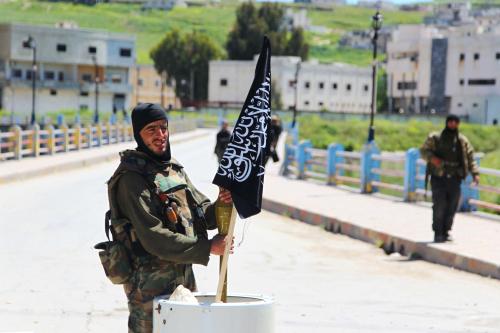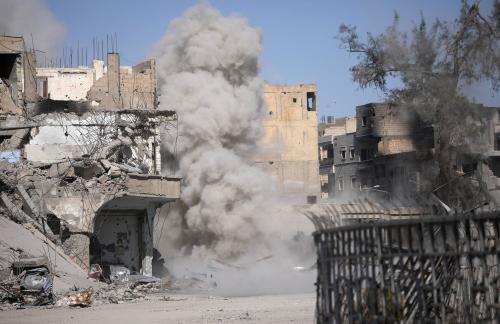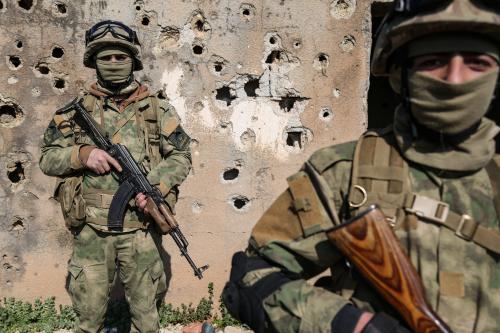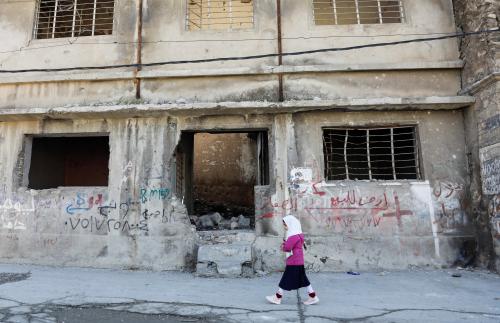The U.S. allies’ conquest of Raqqa marks the end of the Islamic State’s quasi-state status, a devastating blow, writes Daniel Byman. The Islamic State is weak locally and vis-à-vis its jihadists but is likely to gain at least some opportunities for a resurgence in the years to come. This post originally appeared on Lawfare.
U.S. officials are right to crow about the fall of Raqqa and the pain the United States inflicted on the Islamic State in Iraq and Syria. Although Obama administration policies deserve much of the credit, the U.S. allies’ conquest of Raqqa marks the end of the Islamic State’s quasi-state status, a devastating blow. However, when the Islamic State previously fell, it revived as a stronger, more dangerous group. The director of British intelligence has warned of an “intense threat” of terrorism, and terrorism expert Aaron Zelin cautions that “[t]he Islamic State is not finished.” Assessing the situation from the Islamic State’s perspective helps observers to understand both sides of this analytical debate. The group is weak locally and vis-à-vis its jihadists but is likely to gain at least some opportunities for a resurgence in the years to come.
The Islamic State, the successor group to al-Qaida in Iraq, has oscillated between victory and defeat. In 2005, it rode high: The United States was on the edge of defeat in Iraq, and the group’s terrorism and horrific violence had polarized the country. Al-Qaida in Iraq planned to exploit the resulting sectarian civil war by championing the country’s Sunni Muslim community.
But victory turned swiftly to defeat. By 2010, Shiite Muslim militias had left a bloody trail through many Sunni communities. Not only had the group failed to protect Iraq’s Sunnis, but ordinary Iraqis turned against the group because of its brutality, and an array of Sunni militants cooperated with U.S. and Iraqi forces to decimate al-Qaida in Iraq’s ranks and force the group underground. Yet only a few years later, the group exploited the Iraqi government’s discriminatory, anti-Sunni policies and the outbreak of violence in neighboring Syria. In 2014, it surged back into Iraq: At its peak, it ruled territory the size of South Korea, inspired perhaps 40,000 foreign fighters to travel from around the world to join the group, and established or inspired “provinces” in Libya, the Sinai and other parts of the Muslim world.
With Raqqa’s fall, the Islamic State has lost the last of the major cities it once controlled and almost all its territory in Iraq and Syria. Its money flow has dried up, and its stream of volunteers has dwindled to a trickle. Many of its fighters, who the group once boasted would battle to the death, have surrendered or fled. Yet the Islamic State’s past revival suggests it’s too soon to assume the group’s defeat. Consider that despite its major losses, it still has more fighters than when it faced defeat in the past. It is planning to go underground, as it did before in Iraq, and wage an insurgent and terrorist campaign in the territory it once held.
But to sustain an insurgency, the group must develop and expand an underground infrastructure in its former strongholds in Iraq and Syria. If successful, an insurgency will prevent the Iraqi and Syrian governments, foreign troops, or local militias from establishing order and completely stamping out the group. The Islamic State’s heavy reliance on foreign fighters presents a weakness: The foreigners stand out from locals, who frequently resent them, hindering operations in an already-challenging mission. In addition, the group’s paltry finances will encourage local leaders to seek other sources for patronage. Many locals will turn first to those paymasters, and if they are hostile then the Islamic State will have its hands full.
As it attempts to regroup, the Islamic State could benefit from the power vacuum created in its absence. To defeat the Islamic State, someone must develop good governance in its former territories in Iraq and Syria to persuade locals to help uproot the group—an unlikely task that has no credible volunteers. The Islamic State is likely to increase violence against local leaders who cooperate with its many enemies: When operating underground in Iraq, the group waged an assassination campaign that killed hundreds of Iraqi leaders who worked with U.S. forces. Such a campaign can backfire if locals have an alternate source of protection, but without that the intimidation might work. In addition, the Islamic State is likely to seize on divisions between its opponents, who are now more eager to fight one another because they no longer face an immediate threat from ISIS. And having developed a presence in Syria, it has two countries where it can mount a revival, as opposed to the one it had in the past.
The Islamic State is not enemy No. 1 as the war over the carcass of its self-proclaimed Caliphate commences. Already, the Baghdad government is exchanging fire with Kurdish forces. Shiite militias in Iraq are committing abuses against Sunnis in the formerly-ISIS-controlled areas they conquer, and worse can be expected from the murderous Assad regime if it consolidates its presence in former Islamic State territory. Many locals are likely to remain sympathetic to a group that claims to champion the Sunni cause.
Worryingly for those in the United States and Europe, the Islamic State maintains more opportunities for success outside of the Muslim world. Many options available to the Islamic State frighten the United States and its allies but also demonstrate the extent of the group’s demise. Instead of sending conquering armies into the heart of the Arab world to defeat the apostasy and inspire supporters, it will rely on lone–wolf terrorists and other sympathizers to strike the more distant West; many of them are incompetent or do not neatly match the group’s goals. The Islamic State also proved adept at directing or inspiring operations via the Internet. From a U.S. or European political perspective, bombings or shootings in Paris or in an Orlando nightclub are worse than the Islamic State ruling over hundreds of thousands of Iraqis and Syrians.
ISIS may exploit divisions among its many enemies outside of Iraq and Syria. The fight against ISIS brought together Iran, Russia, Saudi Arabia, Turkey and the United States, among other strange bedfellows. Often, the alliance resembled parallel actions rather than real cooperation, but the shared interest served as a check on many rivalries. Now these states can return to ignoring, if not undermining, one another.
Indeed, the Islamic State can take comfort that its enemies, too, face many problems. Kurds and Arabs are shooting each other again in Iraq, and Syria shows little sign of stabilizing. For all the Trump administration’s bombast on terrorism, the United States is not eager or able to provide the region with the good governance required to turn locals away from extremism—a strategy that demands money, troops and constant diplomatic attention. None of these conditions is likely to change soon.
Many of the Islamic State’s remaining challenges primarily originate in the global jihadist world. Al-Qaida leaders long warned that the Islamic State had declared a caliphate prematurely and that locals would turn against the group over its brutality and its refusal to work with other resistance groups. These chickens have come home to roost. In Syria, al-Qaida’s stalking horse, Jabhat Fatah al-Sham, is deeply enmeshed with other anti-regime groups. Outside the region, the Islamic State has a damaged brand: It bragged about its successes, establishing a caliphate and challenging Islam’s enemies. Now it is in retreat, and its caliphate is in ruins. While the Islamic State can still brag that it achieved more than al-Qaida and other jihadist groups, the memory of a caliphate, or a virtual one, cannot match the real one the Islamic State had claimed to rule.
Fortunately for the jihadist movement, the Islamic State inspired many new recruits and has spread its propaganda everywhere. With the fall of Raqqa and the demise of the group more broadly, many of the recruits are up for grabs, and a rival or a new group may eventually pick up the pieces. The Islamic State, after all, benefited when the United States killed Osama bin Laden, decimated the ranks of al-Qaida core’s leadership and otherwise devastated that group’s operational capacity.
In short, there are many reasons not to buy fearmongers’ arguments that the Islamic State will win by losing. But a more lasting victory will require following up on the military campaign and resolving new problems that the Islamic State may attempt to exploit. The United States and other anti-ISIS forces are likely to make fitful progress at best. The Islamic State will remain weak and off-balance, yet it will find some holes in its opponents’ defenses and otherwise maintain itself with the hope of reviving in the years to come.









Commentary
How the Islamic State will grapple with defeat in Raqqa
October 19, 2017